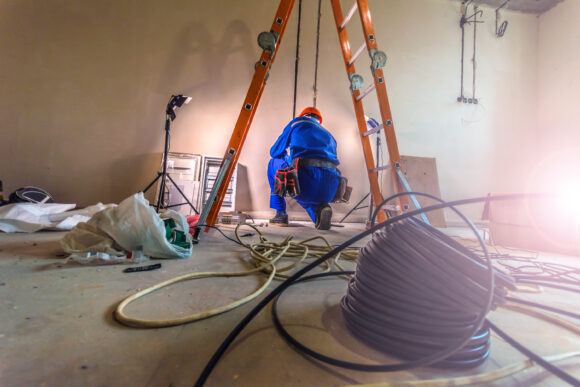The coronavirus pandemic forced most individuals and businesses to stand still for a moment in time, a pause that was challenging for many and cost jobs, income and growth. While many industries are transitioning back to work, some businesses, including those in the construction industry, face new challenges because of the pandemic.
In the United States, lockdowns and strict restrictions on returning to work forced contractors to change the way they work overnight. Even though the pandemic negatively impacted 70% of construction companies, according to Nationwide’s 2021 Agent Authority report, experts predict the construction industry will grow by 5.2% in 2021, a 2.5% increase over 2019, according to Global Data.
As contractors, large and small, return to work and face high demand, here are eight challenges they face and the insurance implications that agents should prepare for now.
1. Delay of Projects
One of the most significant struggles contractors face is the delay of projects. Initially caused by inspections coming to a halt during quarantine, contractors still face delays today. These delays impact contractors in two substantial ways.
First, typical insurance policies are project-based and coverage ends on a specific date, usually the project completion date. If the date arrives but the project isn’t complete, contractors must negotiate with the carrier to extend the coverage or purchase a new policy. Second, many contracts between the contractor and their clients contain delay of project penalty clauses. These clauses state that every day a project is past due, the contractor pays the penalty to the client.
2. Labor Shortages
Contractors feel the pressure of labor shortages, which is forcing them to increase wages to attract more talent.
As a result, contractors can expect their workers’ compensation costs to increase as payrolls rise. These increases could negatively impact the profitability of existing jobs and require price increases on future projects.
3. Supply Chain Delays
When states implemented lockdowns and quarantine protocols, many factories and mills shut down because they were not considered “essential” in most states. Now, these companies face a backlog of work not completed along with an increase in demand for new jobs and materials.
In some cases, the labor shortage exacerbates these delays because, while companies have products and materials, they don’t have employees to deliver them to job sites.
4. Increased Material Costs
Nearly every material needed in the construction industry has seen a price increase due to supply chain shortages, increased labor costs and high demand.
Most contractors didn’t have an escalation clause to cover the increased material costs in their contracts with clients, which means they need to cover these additional expenses or renegotiate existing contracts. In addition, contractors have installation coverage insurance, which covers the material on the job site. As material costs increase, contractors also need to increase their insurance coverage and confirm they have an adequate co-insurance set. It’s important to do this even though it increases their out-of-pocket expenses.
5. Tightening Insurance Markets
To further complicate workflow, many insurance carriers are tightening their stance on the construction industry. Not only do contractors need to be concerned about increased insurance premiums caused by more strict underwriting guidelines, but existing policies are in jeopardy as well.
When a customer or contractor purchases a builder’s risk policy on a project, carriers typically offer a maximum of two years of coverage. Since the pandemic halted many projects in 2020, projects have surpassed the two-year maximum and contractors are finding that carriers are not renewing coverage because of the increased costs and risk. Contractors then have to do a mid-term replacement, which means moving it to another carrier mid-project. It is challenging to find companies that want to take on these types of risks.
6. Technology Changes
The pandemic encouraged many industries to embrace technology in new ways, including video conferencing, digital payment methods, and online project management tools.
By adding these new technologies to their operations, contractors increase the chance of cyber breaches including ransomware attacks where hackers can hold data hostage indefinitely. To minimize stress and costs, cyber liability insurance is recommended to cover these breaches. Many contractors may not understand their exposure and rely on an agent’s insight to see the value.
7. Additional Safeguards
Once contractors could return to work, they faced a new set of safety protocols established by their state, OSHA, and the CDC. These protocols require masks and sanitization guidelines and often limit the number of individuals per business vehicle.
Fewer people per vehicle requires additional vehicles and subsequently more money for maintenance, fuel, insurance and time.
8. Additional Insurance Implications
While the central theme of changes impacting the construction industry increased overall costs for contractors, there are additional insurance implications. Insurance claims increased in 2020 as a domino effect from the pandemic. As insurance carriers review the data, contractors should be prepared to review and understand potential changes to policy language moving forward.
Expect to see exclusions for pandemic-related incidents that contractors will need to buy back via special endorsements at a higher cost than pre-pandemic.
Next Steps for Contractors and Agents
Similar to how insurance companies will look to tighten coverage, contractors should take the time to review project contracts and include clauses that protect their best interests. One recommendation is to incorporate an escalation clause that allows contractors to increase pricing when material costs rise. Another recommendation is to include a provision for a delay in project completion resulting from government shutdowns and pandemics.
Due to the ever-evolving changes resulting from COVID-19, agents should review their existing construction accounts to ensure policies align with new risks and market changes. The first step an insurance agent or broker can take to protect their contractor clients fully is educating them on potential risks. Some coverages to consider recommending to contractors include:
- Workers’ compensation;
- General liability;
- Commercial auto liability;
- Commercial property;
- Cyber liability;
- Inland marine;
- Professional liability;
- Employment practices liability;
- Pollution liability;
- Builder’s risk; and
- Excess liability.
Every contractor is different, and clients will appreciate an agent that proactively looks out for their best interests during this volatile time that continues to cause uncertainty and significant stress.
Topics Liability Construction Contractors
Was this article valuable?
Here are more articles you may enjoy.



 Baldwin Group to Buy CAC Group for About $1B in Cash and Stock
Baldwin Group to Buy CAC Group for About $1B in Cash and Stock  Chubb, The Hartford, Liberty and Travelers Team Up on Surety Tech Launch
Chubb, The Hartford, Liberty and Travelers Team Up on Surety Tech Launch  Florida Jury Returns $779M Verdict for Family of Security Guard Killed at Gambling Cafe
Florida Jury Returns $779M Verdict for Family of Security Guard Killed at Gambling Cafe  Pierce Named CEO of GEICO as Combs Resigns
Pierce Named CEO of GEICO as Combs Resigns 



